Skin Closure with Barbed Sutures: An Early Evaluation of Cosmesis and Complications
Journal of Head Neck & Spine Surgery Juniper Publishers
Abstract
Introduction: Barbed sutures have the potential advantage of decreased operative time and better wound cosmesis due to bidirectional fixation of wound. Present study evaluates the complications and scar cosmesis after skin closure with barbed sutures.
Material and Methods: This was a prospective, observational study. Patients underwent subcuticular skin suturing in surgically created clean wounds. Half of the wound closure was done with barbed absorbable suture and other half with non-barbed absorbable sutures. Comparison of scar cosmesis and wound complications was done.
Results: Mean time taken for suturing per cm of wound was lower in barbed suture group. Suture extrusion rate was higher in barbed suture group. No statistically significant difference was found between cosmesis of scar and rates of infection between the two groups.
Conclusion: The current study did not find any added advantage of using barbed sutures over and above conventional sutures in terms of cosmesis of scar. The only advantage was that of decreased operative time.
Keywords: Barbed sutures; Wound cosmesis; Operative time; Scar; Suture extrusion
Introduction
Barbed sutures have been in use since many decades. They provide effective wound closure due to bidirectional fixation within the wound. The presence of barbs leads to distribution of tension across the wound and also eliminates the need for knots. A barbed suture prevents backward slippage of the sutures, and as a result it does not gape in areas of tension allowing for an aesthetic subcuticular closure. Some clinical studies have shown a better resultant scar.
These sutures allow for a running closure of the wound, with fewer preliminary buried sutures leading to saving of one third to half of the time taken in suturing which can be their greatest benefit [1,2]. This study was done in Indian population where previously no such study has been reported. This study was done by using barbed and non-barbed suture in the same wound by dividing it into two halves thus removing all the confounding factors.
Material and Methods
This prospective, observational study includes 50 patients and was conducted from February 2018 to August 2019. Patients of all age groups were included in the study. The study population consisted of all the patients coming to plastic surgery department at our institute. All patients undergoing primary wound closure in a wound length of greater or equal to 5cm were included in the study. The study included patients with surgically created wounds and included simple surgical incisions and excisional wounds.
Patients with uncontrolled diabetes mellitus, collagen vascular disease, irradiated skin, immunodeficient states, past history of keloid formation, active cutaneous or systemic infection at the time of surgery, chronic renal or hepatic failure were excluded from the study. Preoperatively, patient’s wounds were marked, and dimensions were noted by using Vernier Callipers. Wound was divided into two equal halves and marked. Subcuticular continuous skin closure of one half of the wound was done by conventional polydioxanone sutures while the other half was sutured by barbed polydioxanone sutures. The wound closure was done by the same surgeon. Time taken for surgical closure was noted.
Post operatively various parameters were monitored to evaluate outcome and complications of patients. All patients were followed up for 2 weeks, 1 month, and 3 months after surgery and scar assessment was done by an independent and blinded observer. Scar cosmesis was compared by using POSAS and Vancouver scar scale. Width of the scar, time taken for surgical closure, median scar width and wound infection rates were compared. Wound infection was defined as wound erythema, tenderness or pus discharge from the wound.
Data was entered in Microsoft Excel spreadsheet. Statistical analysis was performed using SPSS (version 18.0). Categorical variables were summarized as frequencies and percentage. Continuous variables were presented as mean and standard deviation or median and inter quartile range based on the normality of data. Normality was assessed using Kolmogorov mirnov test. In case of non-normal or asymmetric distribution, non-parametric test was performed to assess statistical significance.
The following statistical tests were applied
(1) Quantitative variables were compared using Unpaired t-test/Mann-Whitney Test (when the data sets were not normally distributed) between the two groups.
(2) Qualitative variables were compared using Chi-Square test /Fisher’s exact test. A p value of <0.05 was considered to be statistically significant.
Results
A total of 50 patients were studied for a period of 18 months. There were 16 (32 %) women and 34 (68%) men. Maximum (54%) of patients were in the age group of 20-39 years (Table 1). The wounds involved head and neck in 7 patients, trunk in 23 patients, upper extremity in 5 patients, and lower extremity in 25 patients. The width of the scar was evaluated at 2 weeks, one month and 3 months post-operative period. Median scar width (in mm) was compared. Mann-whitney test was performed (Figure 1, 2 and 3).

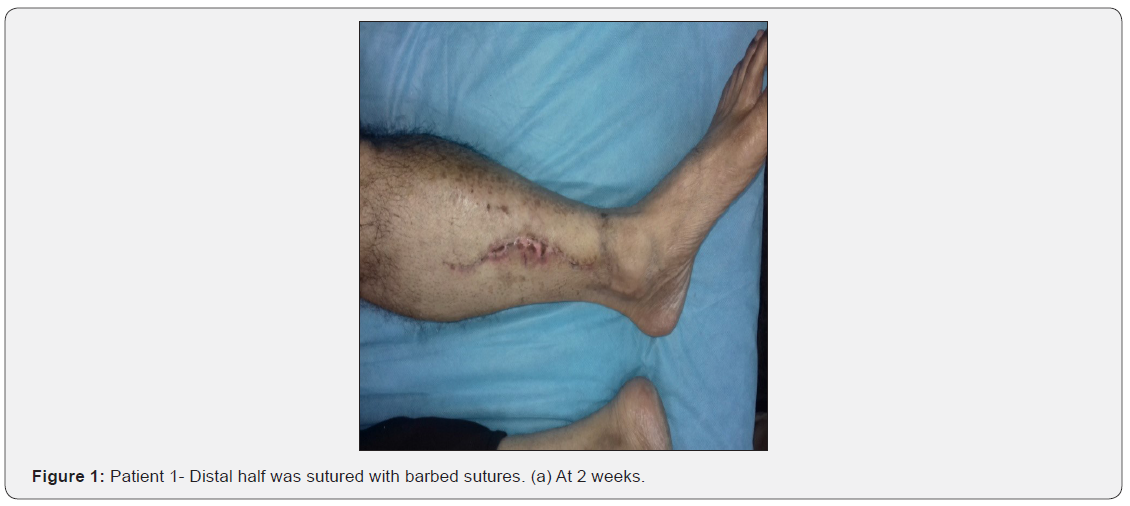
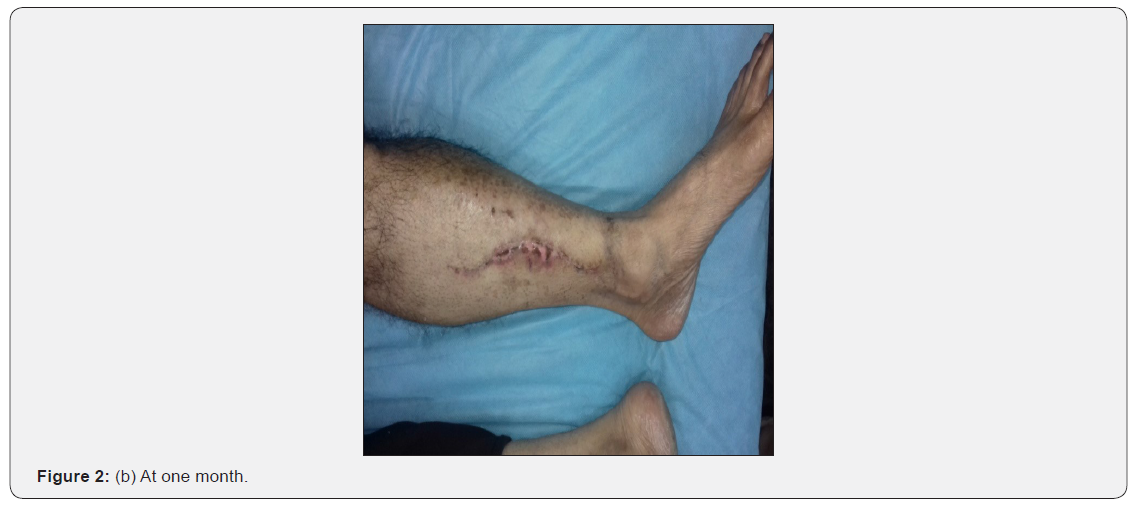
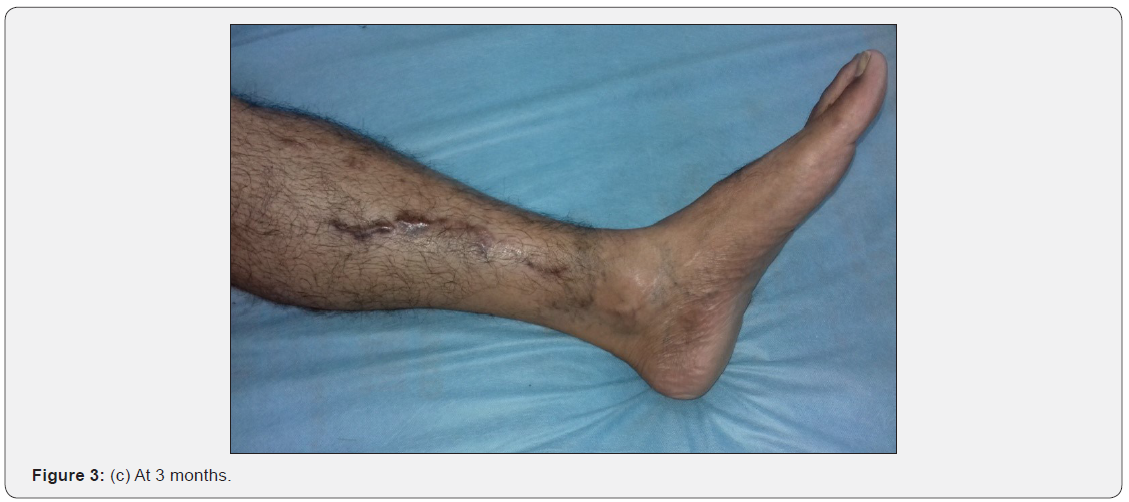
There was no statistically significant difference in the width of the resultant scars between barbed and non-barbed sutures (Table 2). Time taken in suturing per cm of wound between barbed and nonbarbed suture groups was compared. In our study the time taken for barbed suture was less (23.38 seconds per cm of wound) than conventional absorbable sutures (25.16 seconds per cm of wound) and the difference was statistically significant with a p value of 0.001.

Comparison of Vancouver scar scorewas done at 2 weeks, one month and 2 months’ time period. The median scar score was higher for barbed sutures at one-month postoperative period. Mann-whitney test was performed and the difference was not statistically significant (Table 3). POSAS score (patient) was compared at 2 weeks, one month and 2 months’ time period (Figure 4, 5 and 6). Mann-whitney test was performed and the difference was not statistically significant. The median score was same for both the groups at 2 weeks follow up period. The score was higher for barbed suture group as compared with non-barbed suture group at 1 month and 3 months follow up period. But this difference was not statistically significant (Table 4).

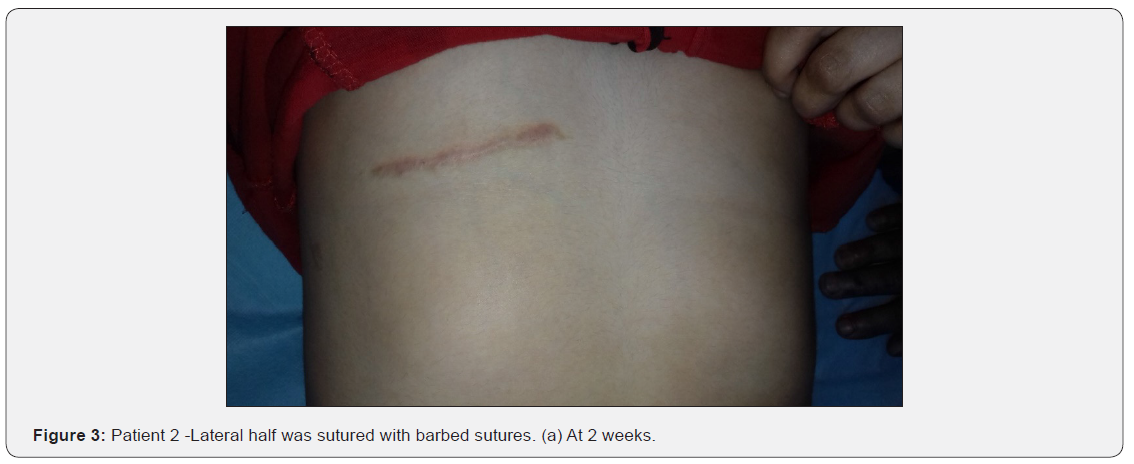
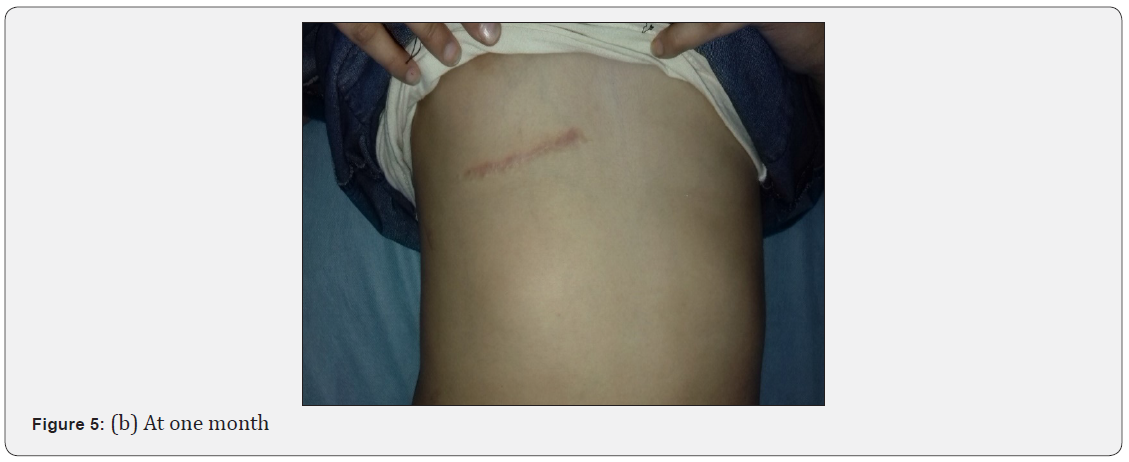


POSAS score (observer) was compared at 2 weeks, one month and 2 months’ time period. The score was higher for barbed suture group as compared with non-barbed suture group at 2 weeks and 1 month follow up period. Mann-Whitney test was performed. The difference was not statistically significant (Table 5). Overall, no significant difference was found in wound cosmesis between barbed and nonbarbed suture group as evaluated by Vancouver scar scale and POSAS observer and patient scar scale. The wounds were evaluated for surgical site complications. Comparison of suture extrusion between groups was done.

In barbed suture group suture extrusion was seen in 9 cases over a period of 3 months. 7 cases were with wounds involving lower extremity and 2 patients with wounds in upper extremity. Only one case of suture extrusion was present in nonbarbed suture group which occurred in upper extremity. Chi square test was performed, p value was <0.01 and the difference was considered as statistically significant. Comparison of surgical site infection at two weeks, one month and 3 months’ time period was done. Chi square test was performed. Higher rate of infection was seen with barbed sutures but the difference was not statistically significant (Table 6).

Discussion
Scarring is an inevitable result of any surgery. Since time immemorial surgeons have been searching for techniques to reduce postoperative starring. Barbed sutures were introduced as tool to reduce scarring. The presence of barbs leads to better tissue fixation and lesser scarring. Theoretically barbed sutures lead to bidirectional fixation of wound which leads to lesser wound gaping and decreased width of resultant scar [1,2]. This was not seen in our study and there was no statistically significant difference in width of the resultant scars between the barbed and non- barbed suture groups.
Decreased width of scar leads to a better aesthetic outcome. A study by Koide et al displayed a significantly better aesthetic outcome in the barbed suture group than nonbarbed suture group [3]. But in our study, there was no statistically significant difference in scar cosmesis as compared by Vancouver scar scale and POSAS (observer and patient scar scale) between the barbed and the non-barbed suture groups. Our findings were similar to studies by Kristen Aliano et al, Amy P Murtha et al, Rubin et al and Grigoryants et al [4-7]. As our study evaluated the scar for only three months, a prolonged follow up is further required to evaluate the scar after remodelling. The time taken per cm of wound was evaluated for both barbed and non-barbed side.
In our study the time taken for barbed suture was less than conventional absorbable sutures and the difference was statistically significant. Similar results were seen in studies done by Koide et al, Kristen Aliano et al, Grigoryants et al, Jeremy P. Warner et al and Blacam et al [3,4,7-9]. Jandali et al, found that using barbed sutures reduced the operative time of unilateral breast reconstruction significantly, but no significant difference was seen in the operative time of bilateral breast reconstruction [10]. The only study showing increased operative time was that by Murtha et al, but the results were not statistically significant [5]. The decreased time taken in barbed suture group in our study is likely because there is no need to put a knot in barbed suture at the ends of the suture line. Also, the handling of suture is improved as the tissue gets fixed with each stitch with a barbed suture.
Our study evaluated the wound for surgical site infection. It was seen that barbed sutures were associated with a higher rate of surgical site infection, but the difference was not statistically significant. Overall, it was seen that the patients having lower extremity wounds had more surgical site infection. This may be due to a greater number of patients having wounds in lower extremity. Also, lower extremity skin is less lax hence wounds are usually closed under more tension leading to wound ischemia and more wound infection. Similar results were seen in studies done by Murtha et al, Jandali et al, where more infections were seen in barbed suture group, but it was not statistically significant [5,10].
Roberto Cortez et al, studied the complications associated with barbed sutures. Their retrospective study found that barbed sutures were associated with significantly higher rates of minor wound complications [11]. The increased incidence of infections in the barbed suture group may be due to the fact that the presence of barbs in the suture leads to colonization of bacteria and resultant higher rates of infection. In our study suture extrusion was seen in 9 out of 50 patients in the barbed suture site as compared to only one patient in the conventional sutures group. The difference was statistically significant. Suture extrusions or stitch abscesses were noted in a total of 10 patients, a probable consequence of the superficial placement of the sutures during subcuticular closure of dermal and subdermal layers.
Similar results were seen in a study done by Rubin et al, which showed increased suture extrusion on the barbed suture side than on the smooth suture side [6]. These findings were consistent with the findings of our study. In a study by Murtha et al, suture extrusion was seen in 10.2 percent of barbed suture subjects as compared with 19.7 percent control suture subjects [5]. The placement of sutures in our study was superficial dermal which might have led to the higher extrusion rate. Further study is warranted to evaluate the extrusion rate of sutures placed in deeper dermis. We used delayed absorbable sutures in our study which could also have contributed the higher rate of extrusion of sutures.
As Grigoryants et al, compared extrusion rate of slow absorbing and rapidly absorbing barbed sutures and found that rapidly absorbing barbed suture had lesser extrusion rate than delayed absorbing barbed sutures [7]. Overall, the complication rate was higher for the barbed suture group. These findings were in contradiction to a study done by Blacam et al, comparing abdominal closure with barbed and non-barbed sutures which found that the complications associated with barbed sutures were lesser. But the follow up period in this study was one month as compared to three months in our study which could have led to the difference in the findings [9].
Conclusion
Barbed sutures lead to decreased operative time but there was no advantage in terms of better scar cosmesis. Though there was an increased rate of surgical site infection barbed sutures, the difference was not statistically significant. The suture extrusion rate with barbed sutures was higher and the difference was statistically significant. Probably study over a larger sample size will give us a better picture. Barbed sutures are costlier than conventional sutures, but their use is less time consuming. So further studies in terms of cost analysis in relation to decreased operative time are warranted to fully evaluate the cost of using these sutures.
To Know More About Journal of Head Neck & Spine Surgery Please click on:
For more Open Access Journals in Juniper Publishers please click on:

Comments
Post a Comment